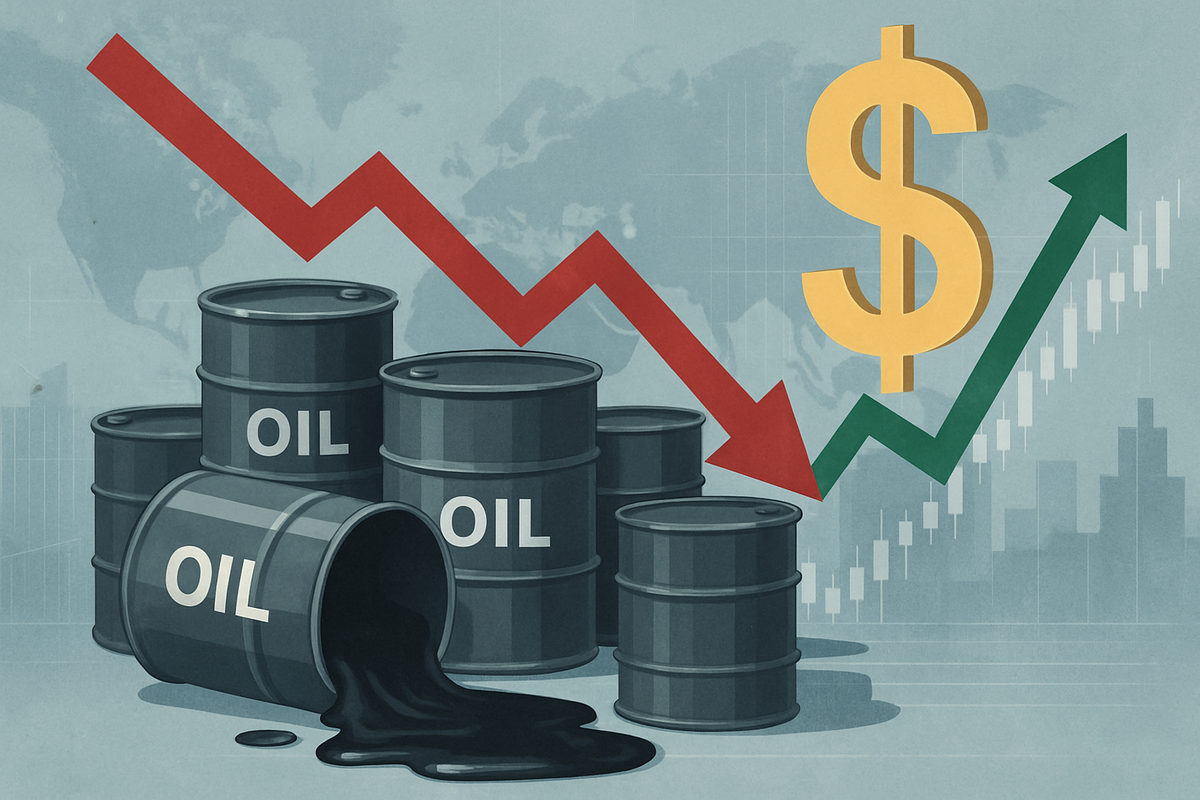
The global crude oil market is currently in a state of flux, experiencing a notable decline in prices as of October 2025. Benchmark crude futures, including West Texas Intermediate (WTI) and Brent, have fallen to multi-month lows, a downturn primarily fueled by a significant outlook of oversupply and a strengthening U.S. dollar. This confluence of factors is sending ripples through global energy markets, forcing a re-evaluation of strategies for producers, consumers, and investors, with particular implications for economies in Asia and Europe.
This bearish shift signals a complex period for the energy sector, moving from a phase of relative stability to one of anticipated decline. The immediate implications include reduced profitability for upstream oil producers, while downstream sectors like refining, airlines, and transportation stand to benefit from decreased input costs. The ongoing dynamic underscores the intricate relationship between global economic health, geopolitical stability, and the fundamental forces of supply and demand in shaping commodity markets.
The Perfect Storm: A Deep Dive into Crude Oil's Decline
As of October 14, 2025, Brent crude futures are trading just below $62 a barrel, settling at $61.60, marking a 7.83% decline over the past month and a 16.29% drop year-over-year. West Texas Intermediate (WTI) crude futures have similarly fallen to approximately $58.3 per barrel, settling at $58.70, a 7.63% decline in the preceding month. Technical indicators suggest further downside, with WTI potentially heading towards $56. This significant price erosion is a culmination of several key events and trends.
The trajectory towards this decline has been building over the past year. Robust non-OPEC+ production, particularly from the United States, Brazil, Canada, Guyana, and Argentina, has been a consistent factor, operating at or near record output levels. The U.S. Energy Information Administration (EIA) forecasts U.S. crude oil production to average an unprecedented 13.5 million barrels per day (bpd) in both 2025 and 2026. This surge in supply from non-OPEC+ countries has been compounded by a gradual unwinding of voluntary production cuts by the OPEC+ alliance, further adding to the global supply glut. The International Energy Agency (IEA) has warned of an impending record global oil surplus of nearly 4 million bpd in 2026.
Simultaneously, global oil demand growth has shown signs of softening. The IEA has trimmed its global oil demand forecast, citing a harsher macroeconomic climate, ongoing trade tariffs, and accelerating transport electrification. Weaker economic conditions, particularly in major consuming nations like China and Europe, have dampened overall consumption, contributing to the oversupply narrative. This has led to substantial global oil inventory builds, with projections for significant increases through Q4 2025 and into 2026, signaling a saturated market.
Adding to the pressure is a strengthening U.S. dollar, which has gained 1.79% over the past month, hovering near 99.35 as of early October 2025. The dollar's rally is fueled by investors seeking safe-haven assets amidst global uncertainties, strong U.S. economic data, and the Federal Reserve's monetary policy. Since crude oil is globally priced in dollars, a stronger dollar makes it more expensive for international buyers holding other currencies, thereby dampening demand and exerting downward pressure on prices. The market has also transitioned into a contango structure, where near-term futures trade lower than longer-dated ones, a bearish signal that encourages storage.
Key players and stakeholders involved in this scenario include the OPEC+ alliance, whose production decisions directly impact global supply. Major non-OPEC+ producers, especially U.S. shale companies, are contributing significantly to the oversupply, often operating independently of OPEC+ coordination. Central banks, like the U.S. Federal Reserve, influence the dollar's strength through monetary policy, indirectly affecting oil prices. Initial market reactions include widespread bearish sentiment, stock market volatility in the energy sector, and increased pressure on oil-exporting nations and producers to adapt to a lower-price environment.
Shifting Fortunes: Winners and Losers in a Lower Oil Price Environment
The decline in crude oil prices is creating a landscape of distinct winners and losers among public companies across various sectors, driven by the interplay of robust non-OPEC+ production, OPEC+ adjustments, and moderating global demand.
Oil Majors (Integrated Oil Companies) with significant upstream (Exploration and Production - E&P) operations, such as ExxonMobil (NYSE: XOM), Chevron (NYSE: CVX), BP (LSE: BP), Shell (LSE: SHEL), and TotalEnergies (NYSE: TTE), are facing direct pressure on revenues and profitability. Their upstream divisions will see reduced margins, potentially leading to cost cuts, reassessed capital expenditures, and reduced shareholder returns. Smaller, independent producers are particularly vulnerable, with some facing risks of falling below their break-even points. However, integrated oil companies with substantial downstream (refining) operations may see some negative impacts offset by improved refining margins, as lower crude input costs benefit this segment.
Refining Companies are poised to be winners. Companies like Marathon Petroleum (NYSE: MPC), Valero Energy (NYSE: VLO), and Phillips 66 (NYSE: PSX) generally benefit from lower crude oil prices because their primary input cost decreases. If demand for refined products remains stable, these companies can see their crack spreads (the difference between crude oil prices and refined product prices) expand, boosting profitability.
The Airline Industry is a clear winner. Jet fuel is a major operating cost, typically accounting for 20-30% of airline expenses. Lower fuel costs directly translate to boosted profit margins, allowing carriers like Delta Air Lines (NYSE: DAL), United Airlines Holdings (NASDAQ: UAL), and EasyJet Plc (LSE: EZJ) to potentially offer more competitive ticket prices or invest in expansion.
Shipping and Logistics companies, including global firms like FedEx (NYSE: FDX) and shipping giants like Maersk (CPH: MAERSK B), will see their operational expenses decrease due to lower bunker fuel costs. This can lead to improved profitability and more competitive freight rates. However, the broader shipping industry faces a complex outlook due to an oversupply of new ships and geopolitical uncertainties, which could temper the benefits of cheaper fuel for some.
The Manufacturing Sector, particularly energy-intensive industries and those relying on crude oil as a raw material, will also emerge as winners. Petrochemical companies will see margin expansion as feedstock costs decline. Paint, lubricant, tire, and specialty chemical manufacturers, where oil or its derivatives constitute a significant portion of raw material costs, will benefit from reduced input expenses, enhancing their competitiveness and profitability.
Conversely, the Renewable Energy Sector might face a mixed impact. While the long-term trend towards renewables remains strong, a sustained period of lower fossil fuel prices could temporarily reduce the immediate economic incentive for some industries and consumers to switch to alternative energy sources. This might create a short-term headwind by making traditional energy sources more competitively priced, though the inherent volatility of crude oil markets may paradoxically accelerate the long-term push for stable, alternative energy.
Wider Implications: A Global Economic Ripple
The current decline in crude oil prices in October 2025 extends far beyond the immediate energy sector, carrying significant broader industry trends, ripple effects, regulatory implications, and historical parallels that will reshape global economies, especially in Asia and Europe.
The overarching trend is a looming global oil surplus, projected to accelerate through late 2025 and into 2026. This oversupply, driven by robust non-OPEC+ production (particularly from the U.S., Brazil, and Canada) and a moderating global demand, is pushing the market into a contango structure, a bearish signal. This environment pressures upstream E&P companies, potentially leading to reduced drilling and industry consolidation, while benefiting refiners and energy-intensive industries. The renewable energy sector faces a nuanced challenge; while lower oil prices might temporarily dampen immediate green investment incentives, the structural shift towards energy security and decarbonization continues, driven by declining costs of clean technologies.
Regulatory and policy implications are significant. Escalating US-China trade tensions, including new 100% tariffs on Chinese goods by the US (effective November 1, 2025), are a major driver of market uncertainty and weakened demand outlook. These tensions disrupt global oil trade and complicate refinery logistics. OPEC+ faces ongoing pressure to balance price support with market share, as its production strategy directly influences the supply side. Governments worldwide are also grappling with energy security concerns, leading to diversification efforts and increased investment in renewables and energy efficiency.
Historically, the current situation shares characteristics with the 1980s oil glut, a supply-driven downturn where increased global output outpaced demand, eventually leading to drastic price falls. It also echoes the 2014-2015 price crash, largely driven by the rapid growth of U.S. tight oil production, a factor still contributing to the current oversupply. While distinct from the demand-driven 2008 financial crisis or the unprecedented 2020 pandemic collapse, the current decline is similarly characterized by a slowdown in demand, albeit less severe. The 2025 downturn is increasingly seen as a "structural overhang" driven by stalled demand and increased OPEC+ output.
For Asian Economies, generally net oil importers, lower oil prices are broadly positive, reducing energy bills and potentially fueling economic growth. This tends to ease inflationary pressures, as seen in Singapore where inflation is low due to declining imported prices. However, soft consumer demand and slowing export growth, partly due to tariffs, could offset some benefits. China's industrial output faces headwinds, but countries like India benefit from discounted crude, managing inflation and trade deficits amidst robust growth.
European Economies are experiencing a gradual recovery, with lower oil prices contributing to contained inflation. The European Central Bank projects headline inflation to average 2.1% in 2025, falling to 1.7% in 2026, reflecting successful monetary policy and weaker demand. While lower oil prices generally reduce input costs for industries and consumers, regional disparities exist. Germany faces industrial headwinds, while southern European economies show resilience. Refinery margins for light sweet crude hit two-year highs in Europe in September 2025, indicating some resilience in the refining sector despite broader industrial challenges. However, the drop in Russian middle distillate exports has created localized price spikes for transportation fuels in Europe.
Navigating the Future: What Comes Next for Energy Markets
The immediate and long-term outlook for crude oil prices and energy markets is shaped by the prevailing oversupply, moderating demand, and a strengthening U.S. dollar, demanding strategic pivots from energy companies and governments alike.
In the short-term (late 2025 - early 2026), the outlook for crude oil prices remains bearish. The EIA projects Brent crude to average around $62 per barrel in Q4 2025, potentially dropping to $52 per barrel in 2026, with WTI following a similar trajectory. This is driven by continued robust non-OPEC+ production, potential for OPEC+ to prioritize market share over price, and weakening demand growth. Global oil inventories are expected to swell, creating significant downward pressure.
Long-term (beyond early 2026), oil prices are likely to remain in a lower range or continue a gradual decline. Global fossil fuel demand is widely expected to peak by 2030, propelled by accelerating energy transition policies, widespread electric vehicle adoption, and renewable energy growth. While geopolitical risks and underinvestment in new production capacity could still create short-term price spikes, the structural forces point to a sustained lower-price environment.
Strategic pivots are crucial. Energy companies, especially E&P firms, will need to prioritize cost discipline, reduce capital expenditures, and optimize their portfolios. Integrated majors may accelerate diversification into renewable energy and lower-carbon solutions, seeing sustained low oil prices as a reinforcement of the need to de-risk from fossil fuel volatility. Governments of oil-producing nations will face increased fiscal pressure, necessitating economic diversification and fiscal reforms to reduce oil dependency. All governments will need to balance energy security with climate goals, potentially adjusting energy policies and continuing support for the energy transition through incentives for renewables and EVs.
Market opportunities will emerge for refiners and petrochemical companies due to lower crude input costs. The fundamental drivers for renewable growth remain strong, driven by policy, technological advancements, and increasing corporate sustainability goals. As inventories build, opportunities may arise in storage and logistics. Conversely, challenges include sustained low prices diminishing incentives for new conventional oil and gas investments, geopolitical instability leading to price volatility, and currency volatility causing "imported inflation" in non-U.S. economies.
Potential scenarios range from a prolonged oversupply and low prices (the most likely outcome), where prices remain depressed and inventories swell, forcing energy companies to intensify cost-cutting and diversification. A market rebalancing with moderate prices could occur if OPEC+ implements deeper cuts and global economic growth proves more resilient. Less likely, but possible, is a geopolitical spike and price volatility due to significant supply disruptions, leading to short-term price surges but potentially accelerating long-term demand destruction.
Conclusion: Navigating a New Energy Paradigm
The recent decline in crude oil prices, driven by a powerful combination of oversupply and a strengthening U.S. dollar, marks a significant shift in the global energy paradigm. This "crude awakening" is not merely a cyclical downturn but reflects deeper structural changes in supply dynamics and demand outlook, further exacerbated by macroeconomic headwinds and geopolitical tensions.
Key takeaways include the persistent challenge of managing robust non-OPEC+ production against moderating global demand, the enduring influence of the U.S. dollar on commodity prices, and the divergent impacts across various industries. While oil-importing economies in Asia and Europe generally benefit from lower energy costs, the benefits are uneven, tempered by broader economic slowdowns, trade tensions, and localized energy market dynamics. Energy companies are compelled to embrace financial discipline, accelerate diversification into lower-carbon solutions, and enhance operational efficiency to navigate this evolving landscape.
Moving forward, the market will likely remain characterized by an oversupplied environment and downward pressure on prices in the short to medium term. Investors should closely watch OPEC+'s future production decisions, global economic growth indicators (particularly from China and Europe), and the trajectory of the U.S. dollar. The pace of the energy transition, the resilience of U.S. shale production at lower price points, and the potential for geopolitical events to disrupt supply chains will also be critical factors to monitor in the coming months. The era of cheap oil, while beneficial for consumers and certain industries, simultaneously accelerates the imperative for a sustainable and diversified energy future.
This content is intended for informational purposes only and is not financial advice


















